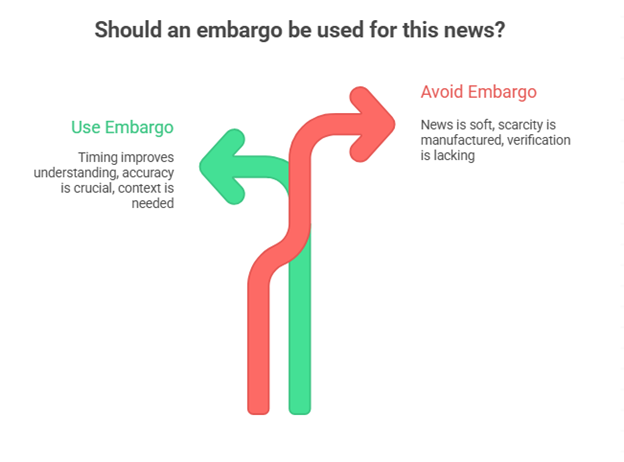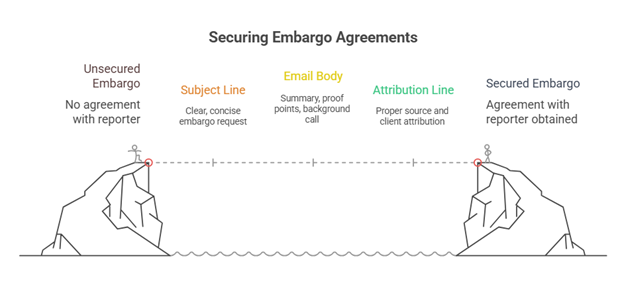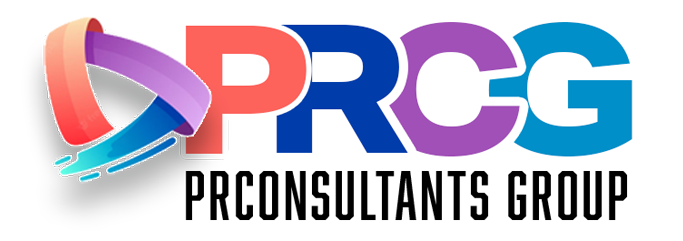If you’ve ever tried to land a clean, coordinated announcement with more moving parts than a Swiss watch, you’ve probably used an embargo. Done right, it buys accuracy and calm. Done wrong, it buys headaches and a Slack channel full of fire emojis.
Embargo definition
An embargo is a simple agreement between you and a journalist to hold your news until a specific date and time. Reporters get the materials early, ask questions and prepare their stories, then publishes the story when the clock hits the agreed lift. The story is still attributed to you, and you must provide verifiable facts, quotes and assets. A proper embargo includes written acceptance, the exact lift time with time zone and clear attribution.
What is an embargo and why should leaders care?
Plain English. In journalism and PR, an embargo is a simple agreement with the press to hold a story until a specific date and time. Reporters can review materials, ask questions and prep coverage. They publish when the clock strikes.
What an embargo is not. It’s not an exclusive. It’s not background. It’s not off the record. With an embargo the reporter still attributes the news to you and you still have to provide facts, assets and quotes.
My point of view. Embargoes buy accuracy and coordination, not hype.
What gets embargoed?
The short list is real news with timing teeth. Think acquisitions and mergers, executive moves, lawsuit filings, recalls and safety updates, market-moving announcements, major product launches tied to an event, peer-reviewed research or data drops and regulatory shifts that hit multiple regions at once.
These can be shared under embargo as a press release, media advisory, backgrounder, data pack, B-roll or even a simple news tip. The format matters less than the timing and clarity.
The goal is to give reporters a head start to verify facts, gather context and line up interviews. When the clock lifts, coverage lands clean, consistent and everywhere at once.
If it’s soft news, minor feature update, routine partnership, feel-good fluff, skip the embargo and ship it on your blog. Embargoes are for moments where simultaneity equals clarity and accuracy matters more than speed.
When should you use an embargo?
Use an embargo when timing improves public understanding.
Multi-stakeholder launches with complex facts that need the same numbers everywhere
Regulated or market-moving news where accuracy and timestamps matter
Research or data drops that need context, charts and a spokesperson on standby
Executive transitions that require synchronized notices to staff, partners, customers and media
Quick test. If releasing at the same time helps people grasp the news and avoids confusion, you qualify.
When should you avoid an embargo?
Soft news or light product updates that can live on your blog
Stories built on manufactured scarcity
Anything you can’t brief fully or verify with proof
If you’re still polishing the numbers, you’re not embargo-ready.
Does an embargo have to be an exclusive?
Short answer: no. An embargo sets timing. An exclusive sets access.
Common models
Embargo, multi-outlet. Same materials to several reporters with the same lift time
Exclusive, no embargo. One outlet gets the story first on their schedule
Hybrid. One outlet gets the first interview; others get embargoed materials for a coordinated lift
How to choose
Need broad coverage and accuracy → multi-outlet embargo
Need depth, a flagship narrative or a relationship play → exclusive
High stakes and you want both → hybrid
Pitfalls to avoid: accidental exclusives, mixed instructions and unequal access without a plan.
Embargo mechanics (make this muscle memory)
Time-zone clarity: Always write the lift like this: “Oct 28, 7:30 a.m. CT (8:30 a.m. ET).” If global, mention key market hours/holidays.
Written acceptance: Require an explicit “I agree to the embargo” reply before sending assets. Log who accepted and when.
Uniform labels: Stamp every file and page header with the lift time and contact line.
Targeting & list hygiene
Who gets it: Beat-matched reporters who’ve shown accuracy and honored embargoes before.
Small is safer: Tighter lists reduce leaks and improve responsiveness.
Keep a log: Outlet, reporter, acceptance Y/N, assets sent, questions, result. Treat it like CRM.
Asset delivery & preflight
Distribution plumbing: Use expiring, view-only links; disable downloads by default; unique URL tokens per outlet.
CMS readiness: Stage your newsroom post as noindex/nofollow; pre-warm the CDN; have the canonical URL ready.
Rights & accessibility: Confirm image/video licensing, captions, photo credits and alt text.
Localization (if relevant): Pre-translate quotes or release snippets for key markets.
Managing the briefing
Pick a format that matches the news and the clock:
Written Q&A for speed and clarity
A 15-minute background call for nuance
A small huddle when several reporters share a beat
State the rules of the road at the start and again at the end. Log every promised follow-up with an owner and a time. Then deliver.
Social and partner coordination
Social embargo: Pre-schedule executive/brand posts for lift-time; give explicit “do not post before” guidance to employees and partners.
Partner copy kit: Provide timestamped copy, links and creative so partners can lift clean with you.
Legal and compliance guardrails
Never promise off the record in an embargo note.
If you’re public or regulated, sync with counsel on quiet periods, Reg FD, exchange rules and trading windows.
Define the publish trigger in writing (court filing timestamp, all-hands start, wire time).
A quick example from the field
We recently ran an embargo for an acquisition targeting a niche audience. We used a hybrid: one exclusive interview for the key trade, plus embargoed materials for others. The press release hit The Wire at 8:30 a.m. CT; the trade story posted at 8:35. Five minutes apart, on purpose. The exclusive gave authority; the embargo protected accuracy. Together, they created lift. It worked because the news was genuinely newsworthy and the choreography was tight.
Read the Auto Recycling World story: https://autorecyclingworld.com/crush-software-solutions-acquires-leading-car-recycling-operating-system/
Another real-world example
For a crisis client filing a lawsuit, we offered an Associated Press reporter an exclusive embargo with access to the firm and the family. The rule: as soon as the filing posted, she could publish. AP moved first. Hundreds of dailies followed. Morning shows picked it up. One well-timed exclusive under embargo delivered reach, accuracy and a clear narrative on day one.
Read the AP Story Here: https://www.jacksonville.com/story/news/nation-world/2017/09/09/water-rushing-discovery-body-ends-harvey-mystery/15772364007/
Why it landed
Real news with human stakes • One reporter, clear rules • Trigger tied to the filing • Quotes and data ready
How to ask for an embargo the right way
Subject lines
Embargoed for Oct 28, 7:30 a.m. CT: data on [topic]
Requesting interest under embargo: interview with [exec], details inside
Email body template
Opening line: “Sharing news under embargo until Oct 28, 7:30 a.m. CT. Confirm if you agree and I will send the materials.”
One paragraph summary with proof points
Offer a 10-minute background call
Include the embargo date, time, time zone and attribution line
Attribution line
“Attribution: Jo Trizila, Founder and CEO, TrizCom PR, on behalf of [client].”
Keep it short. Reporters have eyes and calendars. Respect both.
Leak prevention that actually works
Get explicit acceptance in writing before you send anything
Share via private link with expiry and view-only defaults
Watermark PDFs with outlet name and timestamp
Use unique tracking links per outlet to spot early access
Store all press assets in one versioned folder
Keep the list small. Fewer recipients, fewer risks
Run a two-minute embargo briefing so no one freelances
What happens if an embargo is leaked?
Unfortunately, embargoes do leak. I’ve lived it. Most PR shops have too. It’s a known risk. That’s why the client must buy into the plan from the start. You can’t hold anyone legally responsible when it happens. You accept the risk because the reward usually outweighs it.
Minute 0–10: Stabilize. Confirm the leak. Screenshot URLs and timestamps. Pause outbound sends. Alert the core team. Lock the facts doc so one owner approves edits.
Minute 10–30: Pick the simplest fix.
Partial/low reach → keep your original lift; quietly add context with briefed outlets.
Full/spreading → publish now on owned channels and send the link to briefed outlets.
Public lines
Holding: “We are aware of early reporting on [topic]. Full details will be available at [time, time zone].”
Early lift: “Sharing full details now to ensure accuracy and context,” then link to your post.
Reporter lines
Holding: “We’re keeping the original lift so everyone gets the complete story. Happy to answer clarifying questions so you’re ready.”
Early lift: “We published early to keep facts clean. Here’s the link, quotes and assets you already have.”
After the dust settles: Thank outlets that honored the embargo. Note patterns if you can. Trim the next list. Tighten controls. Add two lines to the post-mortem: what leaked; what changes.
When an embargo goes wrong (and what it taught me)
Years ago, on a corporate relocation, I gave an exclusive embargo to a national daily newspaper I trusted. The reporter did their job and confirmed with a second source. The piece ran two days early. Employees hadn’t been told. Painful.
Lessons
Employees first • If internal comms aren’t done, you’re not ready • Exclusives raise the stakes • Assume verification
What I’d do now
Sequence: employees → partners → press • Put the trigger in writing • Keep the circle small, watermark assets • Keep a short confirm ready • If people risk is high, skip the exclusive and use a tight multi-outlet embargo after internal comms land
Publication day orchestration
Sequence matters
Newsroom post goes live with your press release and embargoed story
Press sends land
Executive LinkedIn publishes
Partner emails go out
Have chyron copy ready for broadcast. Track live stories and update your newsroom with rolling links so your audience doesn’t play scavenger hunt.
Metrics that matter
Embargo acceptance rate
Hit rate within the first two hours of lift
Coverage quality: tier, accuracy, message pull-through
Share of search movement at seven and 30 days
Referral traffic from outlet-specific UTMs
Search & measurement extras
Track branded + category keywords in search.
Give each outlet a unique UTM.
Score each article for accuracy and message pull-through
Wrap-Up & What Matters
Embargoes are not magic; they are choreography. When the story is real, the timing tight and the proof airtight, an embargo turns chaos into clarity. Use it to help reporters get the facts right, keep stakeholders in sync and land coverage that actually travels. Skip it when the news is soft or the numbers are still moving. If a leak happens, do not panic. Steady the ship, publish what is true and keep going.
Call to Action: Put TrizCom PR on the Clock
If you have market-moving news, a delicate transition or a launch that needs to hit everywhere at once, let us make it clean. TrizCom PR can run an Embargo Preflight, build a tight target list and secure written acceptances orchestrate briefings and proof packs and social or partner lifts and stand up a leak response plan with a newsroom ready to publish.
Contact TrizCom PR for a fast read on whether your announcement qualifies and how to make it land on time, accurately and all at once.
DOWNLOAD YOUR FREE EMBARO CHECKLIST
Everyone has a story. Let TrizCom PR tell yours!
About the Author:
Jo Trizila – Founder & CEO of TrizCom PR
Jo Trizila is the founder and CEO of TrizCom PR, a leading Dallas-based public relations firm known for delivering strategic communications that drive business growth and enhance brand reputations as well as Pitch PR, a press release distribution agency. With over 25 years of experience in PR and marketing, Jo has helped countless organizations navigate complex communication challenges, ranging from crisis management to brand storytelling. Under her leadership, TrizCom PR has earned recognition for its results-driven approach, combining traditional and integrated digital strategies to deliver impactful, measurable outcomes for clients across various industries, including healthcare, technology and nonprofit sectors. Jo is passionate about helping businesses amplify their voices and connect with audiences meaningfully. Her hands-on approach and commitment to excellence have established TrizCom PR as a trusted partner for companies seeking to elevate their brand and achieve lasting success. Contact Jo at jo@TrizCom.com.









